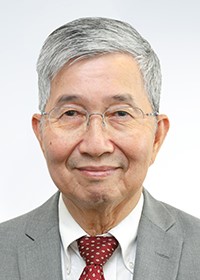
Ching W. Tang
Emeritus Professor of Chemical Engineering
PhD, Cornell University, 1975
- Office Location
- 4003 Wegmans Hall
- Telephone
- (585) 275-3552
- Fax
- (585) 273-1348
Biography
Selected Honors & Awards
Kyoto Laureate (2019)
National Inventors Hall of Fame Inductee (2018)
C&C Prize (2018)
IEEE Jun-ichi Nishizawa Medal (2017)
Nick Holonyak Jr. Award by The Optical Society (2014)
Eduard Rhein Technology Award (2013)
Wolf Prize in Chemistry (2011)
Honorary Doctorate, Shanghai University (2010)
Lifetime Achievement Award, University of Rochester (2010)
Daniel E. Noble Award, IEEE (2007)
Member of the U.S. National Academy of Engineering (2006)
Humboldt Research Award, Humboldt Foundation, Germany (2005)
American Chemical Society Award for Team Innovation (2003)
Fellow, Society for Information Display (2002)
Inventor of the Year Award, Rochester Intellectual Property Law Association (2002)
Jan Rajchman Prize, Society for Information Display (2001)
Carothers Award, American Chemical Society (2001)
Northeast Regional Industrial Innovation Award, American Chemical Society (2001)
Eastman Innovation Award, Eastman Kodak Company (2000)
Fellow, American Physical Society (1998)
Research Overview
Our research is focused on two areas: (1) developing high-efficiency and low-cost solar cells, and (2) advancing the technology of organic light emitting diode (OLED) for display and lighting applications. We fabricate thin-film devices using a suite of vacuum deposition and solution process tools, including vapor deposition of multi-component amorphous organic thin films and close-space sublimation of II-VI semiconductors at high temperature to form crystalline films. We design device architectures - planar, bulk, and graded heterojunctions of organic donors and acceptors - for mediating charge generation, recombination, and transport in OLEDs and organic solar cells. We develop low-impedance contacts for electron and hole injections into semi-insulating materials. Our interest in solar cell work includes the development of methods for fabricating high-efficiency CdS/CdTe solar cells with ultra-thin CdTe films, aiming at significant reduction in material usage. We are also interested in further improving organic solar cell efficiency through design of novel device architectures and material compositions. Another major research effort is to advance OLED technology. Specifically we focus on developing highly stable and efficient white emitters for lighting applications, including light-scattering layers for enhanced light extraction.
Research Interests
- Organic Electronics
- Thin-Film Devices
- Display Technology
- Organic Light Emitting Diodes
- Organic Solar Cells
- II-VI Semiconductors
- CdTe Solar Cells
- Thin-Film Deposition & Characterization
Selected Publications
- Angel, F.A.; Gao, R.; Wallace, J.U.; Tang, C.W.,"Silver-induced Activation of 8-hydroxyquinolinato Lithium as Electron Injection Material in Single-Stack and Tandem OLED Devices," Organic Electronics, 2018, 59, 220-223.
- Angel, F.A.; Wallace, J.U.; Tang, C.W., "Effect of Lithium and Silver Diffusion in Single-Stack and Tandem OLED Devices," Organic Electronics, 2017, 42, 102-106.
- Dong, S.C.; Xu, L.S.; Tang, C.W., "Chemical Degradation Mechanism of TAPC as Hole Transport Layer in Blue Phosphorescent OLED," Organic Electronics, 2017, 42, 379-386.
- Li, J.H.; Xu, L.S.; Tang, C.W.; Shestopalov, A.A., "High-Resolution Organic Light-Emitting Diodes Patterned via Contact Printing," ACS Applied Materials & Interfaces, 2016, 8, 26-16809-16815.
- Xu, L.S.; Tang, C.W.; Rothberg, L.J., "High Efficiency Phosphorescent White Organic Light-Emitting Diodes with an Ultra-Thin Red and Green Co-Doped Layer and Dual Blue Emitting Layers," Organic Electronics, 2016, 32, 54-59.
- Angel, F.A.; Tng, C.W., "Understanding the Effects of Triplet Sensitizers in Organic Photovoltaic Devices," Organic Electronics, 2016, 30, 247-252.
- Glowacki, E.D.; Marshall, K.L.; Tang, C.W.; Sariciftci, N.S., "Doping of Organic Semiconductors Induced by Lithium Fluoride/Aluminum Electrodes Studied by Electron Spin Resonance and Infrared Reflection-Absorption Spectroscopy," Applied Physics Letter, 2011, 99, 4-043305.
- Zhang, M.; Wang, H.; Tang, C.W., "Effect of the Highest Occupied Molecular Orbital Energy Level Offset on Organic Heterojunction Photovoltaic Cells," Applied Physics Letter,2010, 97, 14-143503.
- Lin,H.; Xia, W.; Wu, H. N.; Tang, C.W., "CdS/CdTe Solar Cells with MoOx as Back Contact Buffers," Applied Physics Letters,2010, 97, 12-123504.
- Zeng, L.; Tang, C.W.; Chen, S.H., "Effects of Active Layer Thickness and Thermal Annealing on Polythiophene: Fullerene Bulk Heterojunction Photovoltaic Devices," Applied Physics Letters,2010, 97, 5-053305.
- Rajeswaran, M.; Blanton, T.N.; Tang, C.W.; Lenhart, W.C.; Switalski, S.C.; Giesen, D.J.; Antalek, B.J.; Pawlik, T.D.; Kondakov, D.Y.; Zumbulyadis, N.; Young, R.H., "Structural, Thermal, and Spectral Characterization of the Different Crystalline Forms of Alq(3), Tris(quinolin-8-olato)aluminum(III), an Electroluminescent Material in OLED Technology," Polyhedron,2009, 28, 4-835-843.
- Culligan, S.W.; Chen, A.C.A.; Wallace, J.U.; Klubek, K.P.; Tang, C.W.; Chen, S.H., "Effect of Hole Mobility through Emissive Layer on Temporal Stability of Blue Organic Light-Emitting Diodes," Adv. Funct. Mater.,2006, 16, 1481-1487.
